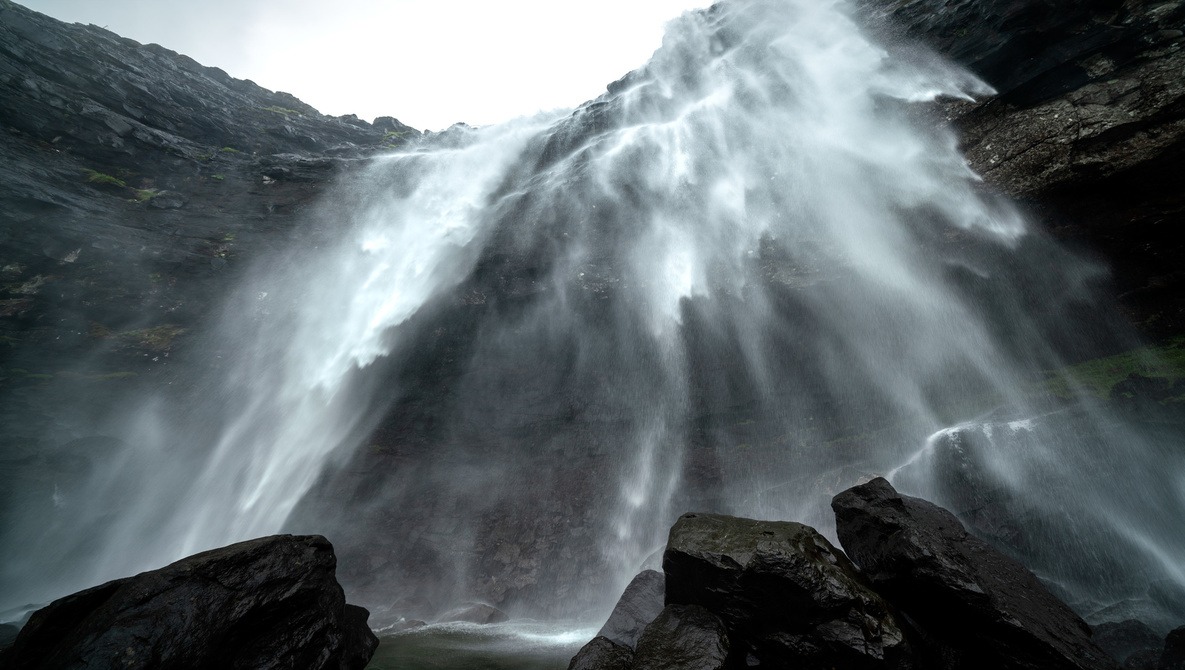It is hard to photograph in both rain and around waterfalls. Here are five tips on how to get the shot.
Have you ever photographed in rain or around waterfalls with a lot of water spray in the air, not to mention along the coast with sea spray? One thing is to compose your photo and nailing the settings, another is to not ruin your camera or having water all over the front element.

Tip 1: Bring the Right Gear
It goes without saying you need to bring the right gear. The cocktail of water and electronics are usually a bad idea, so bring a weather-sealed camera and lens. If you are unsure about how weather-sealed your camera is, you can always use a rain cover for your camera. However, these can be hard to work with and can compromise your patience and thereby your composition and quality of your photo.
Bring some lens cloths that actually absorb the water-spray. Some cloths just smudge the water around on your front element deeming them next to useless. Alternatively, bring some napkins to remove the water and a lens cloth to remove the small paper particles the napkin leaves behind.

Tip 2: Keep Yourself Dry
There is nothing more demotivating for photography than being wet and cold. Waterproof clothing such as rain jackets, rain pants, and wellies are god-sent in situations with a lot of water. If I shoot near or in a river or along a beach wellies makes a huge difference compared to hiking boots. Potentially also wear a waterproof hood or hat.

Tip 3: How to Shoot
There are different ways on how to shoot and below are two. For both I highly recommend photographing in manual and put in the settings. No settings on auto!
The first way is to find your composition and settings and ignore the water spray on the lens. Put your shooting style into continuous or high speed. When you are all set, turn away from the water spray and wipe off your lens or filter. When you are ready point your camera towards your composition and immediately hammer off a series of exposures. Chances are one of the first exposures are sharp and free of water droplets.
The other approach is to put the camera on a tripod, as above, put in the required settings on manual, and use continuous shooting. Wipe off your front element or filter and keep having the cloth covering the lens. When you are ready start shooting by holding down the trigger just before you remove the cloth. The first frame free of the cloth should then be clean from water droplets.
These were my three tips. Do you have more tips for shooting in wet conditions? Share them down below.







I don't think it is wise to recommend using a napkin..... Paper products can cause scratches on your lens very easily.....
Blot, don't rub.
With how much glass costs these days I wouldn't take the risk. Maybe a micro fibre shammy...
Please show me that napkin, which can scratch glass... It does not exist. Glass is very hard, especially in lenses. Paper or fabric are not hard enough to scratch glass. The problem are tiny particles, like sand. They can damage the lens coating.
There is a video on Youtoube from the DigitalRev guys, where they try to scratch a lens... unfortunately I don't find it anymore... it's actually worth to watch.
Paper products can scratch glass. Continued use over time will create fine scratches. And with the price of lenses today why would you take the risk? If you personally feel its ok then go ahead, but in a article offering tips I would never recommend someone use napkins or paper based products on a camera lens......
No it not makes scratches in the glass. It is the coating. But you can also ruin the coating by cleaning the lens too often and with too much pressure. The problem there is also dust. That is the reason why you should blow the lens first.
Also you will usually not notice tiny scratches in the picture. Probably only if you always stop fully down. It's the same like sensor spots.
I will search for the video I mentioned, then you will see, what it takes to damage a lens.
And back to the topic: I'm unsing https://www.bhphotovideo.com/c/product/1049379-REG/manfrotto_mb_pl_e_690... for protection against rain oder water.
My motto: pray and stay!
I usually call it a day and go home.
Joking aside, seriously wet was Rio few years ago, shooting a hyper-lapse coming out of a rocky cove, getting utter mashed by the waves.
A little forethought, knowing I was gong to be near water for a few days, I took a relatively cheap Ewa-marine bag with me to house the camera.
The tl;dr version:
1. Don't let your camera get wet
2. Stay dry yourself
3. Remove water drops from lens before shooting
"Here are five tips on how to get the shot." "These were my three tips." counting is very difficult, isn't it?
Bring 2 gallon ziplock bags with some desiccant packs for after the shoot and seal in the camera gear to get it dried out nicely overnight.